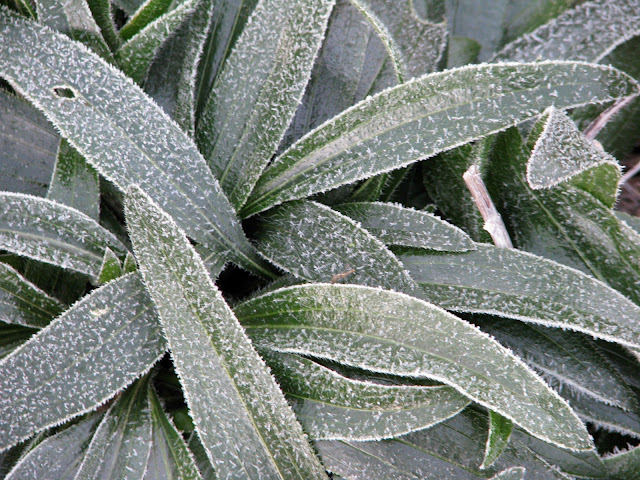When I snapped these photos on Saturday morning, the temperature was in the upper 30s and there was a touch of frost on the roof.
The cooler weather seems to intensify the colors of the prairie flowers that are still blooming. Other flowers, like the Liatris, bloomed over the last month and now their colors are fading.
The cool, morning moisture deepens the now coppery colors of the Little Bluestem grass.
Autumn Sage, Mealycup Sage, and Four Nerve Daisy bloomed throughout most of the summer and they continue to bloom through the autumn months. But there are some plants that waited all season for their time to bloom. These are the last plants to bloom on my prairie before frost changes all the vibrant colors to brown.
The purple flowers of Aromatic Aster, Symphyotrichum oblongifolium, (foreground) and the white flowers of Fragrant Mistflower, Eupatorium havanense, (background) started to appear a couple of weeks ago and now the plants are in full bloom. The flowers of both plants are popular with the bees once the sun warms the air.
Here is a closer look at the Fragrant Mistflower bush. The plant does not get much attention most of the year, but when fall comes around, it catches the eye with its profusion of white flowers and the nose with its strong scent that reminds me of dryer sheets.
Fragrant Mistflower intermingled with Scarlet Sage, Salvia coccinea.
A close up of the Aromatic Aster with Autumn Sage in the background.
Willowleaf Aster, Symphyotrichum praealtum, is covered in pink flowers. It grew from a single sprig to a four foot patch in just a couple of seasons. Its days may be numbered if it continues aggressively expand its footprint.
Here is a close up of the Willowleaf Aster flowers.
The large red flowers of Mountain Sage, Salvia regla, would be popular with hummingbirds if they were still in the area. Mountain Sage probably blooms at just the right time to feed migrating hummingbirds in its native range from the Chisos Mountains of west Texas and into Mexico. This is one salvia that prefers some afternoon shade. Mine gets full afternoon sun which causes the leaves to turn a little yellowish.
Mountain Sage, Beebrush and Mealycup Sage make a patriotic red, white and blue display. A rain and hail shower a week ago triggered another fragrant flush of flowers on the Beebrush.
The spiny Eringo flowers are still interesting as they fade from purple to brown. Since this is an annual, I take the seeds from the dried flowers and scatter them across the prairie for another season of flowers.
The chile pequins, Capsicum annuum, are covered in pea-sized peppers. The peppers are a treat for mockingbirds and are gobbled up whole once they turn red.
Winecup, Callirhoe involucrata, blooms in early summer and then most of the trailing stems die back in the heat of the summer. In the fall, a rosette forms and stays green throughout the winter. This plant produced a rare late season bloom.
The cooler temperatures and shorter daylight hours tricked the Redbud tree into blooming out of season.
As the seasons change, frost and freezing temperatures will eventually change the reds, yellows, blues, purples, and whites in my prairie to various shades of brown. All the while, new life is sprouting in the prairie. The fuzzy leaves of Bluebonnet seedlings bring hope of flowers in the spring. The heart-shaped leaves of Dichondra bring promise of many more seasons on my hands and knees plucking them from my prairies.









